
Silk Road Trade & Travel Encyclopedia
丝绸之路网站(丝路网站)
丝绸之路百科全书—游客、学生和教师的参考资源
İPEK YOLU ve YOLLARI ANSİKLOPEDİSİ
www.ipekyollari.net

Silk Road Trade & Travel Encyclopedia
丝绸之路网站(丝路网站)
丝绸之路百科全书—游客、学生和教师的参考资源
İPEK YOLU
ve YOLLARI
ANSİKLOPEDİSİ
www.ipekyollari.net
D
A B
C
D
E
F
G
H I
J
K
L
M
N O P
Q
R
S
T
U V
W
X
Y
Z
Da Ming Hun Yi Tu (The Great Ming Amalgamated Map) is a world map produced in China during the Ming Dynasty, and is one of the oldest surviving world maps from East Asia. Scholars believe that the Da Ming Hun Yi Tu was ultimately based on a world map named Shengjiao Guangbei Tu, which was created by Li Zemin during the Mongol Yuan Dynasty (a map that is now lost).
Dadu, Daidu (Peking, present-day Beijing) was the capital of the Mongol-Yuan Empire, also known as Mongol China's winter capital (the city of Peking received its present name during the Ming Dynasty). The Mongols had used the old Jin Dynasty capital of Zhongdu as their headquarters for occupied north China, and when Kublai Khan came to power he built a new city named Daidu, after 1265. (see Xanadu)
Dahe The ruins of the ancient city of Dahe are located in Hami Prefecture in the Xinjiang Uygur Autonomous Region of China. To the northeast of Dahe are the Karsan ruins, west lies ruins of the Neolithic Period, to the southwest is the Wubao Ancient Tombs, to the south is the Islamic King Tombs, and to the east one can visit the cliff carvings at Baishan, Qincheng.
Dark Ages of Europe The Dark Ages was a period in European history. The term "Dark Ages" was originally intended to denote the entire period between the fall of Rome and the Renaissance (See Middle Ages). In the 19th century scholars began to recognize the accomplishments made during the period, thereby challenging the image of the Middle Ages as a time of darkness and decay in Europe. The term is now never used by scholars to refer to the entire medieval period, but when used, it is generally restricted to the Early Middle Ages.
Daxia The name Daxia is used by the explorer Zhang Qian to designate Bactria. The name Daxia appears in Chinese from the 3rd century BC to designate a mythical kingdom to the West (possibly a consequence of the first contacts with the expansion of the Greco-Bactrian Kingdom) and then is used by the explorer Zhang Qian in 126 BC to designate Bactria.
The reports of Zhang Qian were put in writing in the Shiji ("Records of the Grand Historian") by Sima Qian in the 1st century BC. They describe an important urban civilization of about one million people, living in walled cities under small city kings or magistrates. Daxia was an affluent country with rich markets, trading in an incredible variety of objects, coming as far as Southern China. By the time Zhang Qian visited Daxia, there was no longer a major king, and the Bactrian were suzerains to the nomadic Yuezhi, who were settled to the north of their territory beyond the Oxus (Amu Darya). Overall Zhang Qian depicted a rather sophisticated but demoralized people who were afraid of war. Following these reports, the Chinese emperor Wu Di was informed of the level of sophistication of the urban civilizations of Ferghana, Bactria and Parthia, and became interested in developing commercial relationship with them:
These contacts immediately led to the dispatch of multiple embassies from the Chinese, which helped to develop communications and trade along the the Silk Road.
Dede Korkut (The Book of Dede Korkut) is the most famous epic stories of the Oghuz Turks. These epic stories were orally told and transferred over the generations before published as a book. There are numerous versions collected of the stories. Some scholars believe that the stories and songs have emerged no earlier than the beginning of the 13th century and were written down no later than the beginning of the 15th century. Other scholars maintain the stories originated centuries earlier. The social lifestyles, morals and values of Turkic peoples living in Central Asia is described in the "Book of Dede Korkut." More...
Desert The most well known desert of the Silk Road is the Gobi Desert. This desert is the fifth largest in the world. The Gobi is most notable in history as part of the great Mongol Empire, and as the location of several important cities along the Silk Road. It is a large desert region in Asia. It covers parts of northern and northwestern China, and of southern Mongolia. The desert basins of the Gobi are bounded by the Altai Mountains and the grasslands and steppes of Mongolia on the north, by the Hexi Corridor and Tibetan Plateau to the southwest, and by the North China Plain to the southeast. The Gobi is made up of several distinct ecological and geographic regions based on variations in climate and topography. It is a treasure chest of fossilized dinosaur bones and eggs.
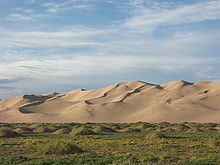
The Taklimakan is another desert in the region of the Silk Road. Merchant caravans on the Silk Road would stop for relief at the thriving oasis towns. The Taklimakan desert in Central Asia, in the Xinjiang Uyghur Autonomous Region of the People's Republic of China, is the world's 17th largest desert. More...
Diplomat (See Emissary) A representative, envoy, or agent, sent on a mission to represent or advance the interests of another. Often the individual was part of a delegation. Envoys were sent both eastward and westward along the Silk Road to the courts and kingdoms of powerful rulers. More...
Divanü Lügati't-Türk In the 11th century Muhmud Kashgari of Kashgar, compiled the first complete Turkish dictionary known as the Divanü Lügati't-Türk.
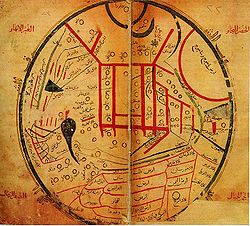
Map from the 11th century Divanü Lügati't-Türk
Dunes (Sand Dunes) In physical geography, a dune is a hill of sand built by aeolian processes. Dunes occur in different forms and sizes, formed by interaction with the wind.
Many modern-day travelers wish to experience dunes and Silk Road desert travel. The photo above shows a group of tourists riding two-humped camels in the popular resort area known as the "Singing Sand Dunes" in the suburb of Dunhuang City, northwest China Gansu Province (Xinhua photo). Dunhuang not only offers visitors the chance to relive a journey along the Silk Road, but it also enables them to see the ancient frescoes and carvings of the Mogao grottoes, which are some of China's best preserved examples of Buddhist art.
Dunhuang (Dungunag Caves, Mogao Caves/Grottoes) The Silk Road forked near Dunhuang, an oasis amid the Gobi Desert, in the Chinese province of Gansu, skirting the treacherous Taklimakan Desert and forcing caravans to choose between the northern and southern routes. Fear of the perilous open desert inspired merchants and pilgrims to construct cave shrines to ensure safe passage, or as thanks for a successful journey. Trader's temples to good fortune are located at the Mogao Caves, where murals, manuscripts, and statuary from the fourth to the fourteenth centuries can be found. According to historical records, Buddhist monks first began work on the caves of Mogao in 366 AD.
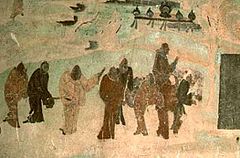
The travel of
Zhang Qian
to the West (depected in the Mogao Caves, 618-712 AD).
(In the 2nd century BC, Zhang Qian was an imperial envoy of the Han Emperor Wudi).
The ancient town of Dunhuang (Shazhou) at the head of the ancient trade route the Silk Road, was founded as a prefecture during the early Han Dynasty, some two thousand years ago. This was a period when the Chinese first came into large-scale contact with communities to their west. Over the following centuries, Buddhist grottos were built, which featured exquisite wall paintings and stone sculptures. During the Song Dynasty (960-1279 AD) the site fell into oblivion. It was discovered in about 1900, by Wang Yuanlu, a Daoist monk who was guardian and abbot of the caves. A walled-up library where a great collection of manuscripts were stored was also discovered. More...
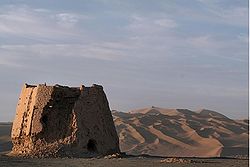
The ruins of a Han Dynasty (202 BC - 220 AD) Chinese watchtower at Dunhuang, Gansu province on the eastern edge of the Silk Road
See the Dunhuang Project Dunhuang Academy China (The International Dunhuang Project (IDP) is a collaborative project which aims to digitize and research all the archaeological artifacts from the Eastern Silk Road. Collaborating institutions and partners seek to make information and images of all manuscripts, paintings, textiles and artifacts from Dunhuang and archaeological sites of the Eastern Silk Road freely available on the Internet, and to encourage their use through educational and research programs).
See UNESCO Situated at a strategic point along the Silk Route, at the crossroads of trade as well as religious, cultural and intellectual influences, the 492 cells and cave sanctuaries in Mogao are famous for their statues and wall paintings, spanning 1,000 years of Buddhist art. Since they were still occupied by Buddhist monks from the end of the 19th century until 1930, the rock-art of Mogao, now administered by the Dunhuang Cultural Relics Research Institute, preserves the example of a traditional monastic settlement.
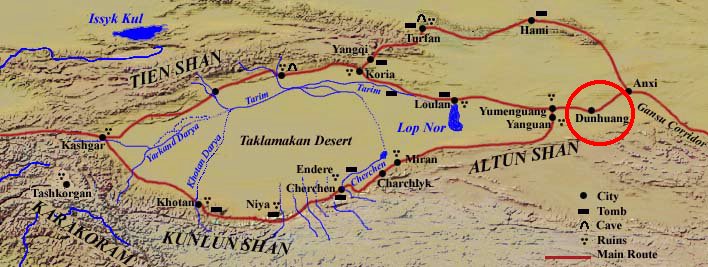
From Dunhuang in Gansu province, travelers can travel west to
visit other sections of the Chinese Silk Road in Xinjiang,
or can travel to other Chinese provinces such as
Qinghai, Ningxia, Shaanxi, and Henan.
Dynasties in China (Imperial China) Chinese civilization originated in various regional centers along both the Yellow River and the Yangtze River valleys in the Neolithic era, but the Yellow River is said to be the Cradle of Chinese Civilization. The Dynasties of China are listed below. More...
Dynasties (Islamic Empires) Islamic civilization originated in various regional centers stretching from the Middle East into Africa, Europe, and Asia (7th –19th century). The Later Islamic Dynasties and Empires inevitably had a profound impact on life and trade along the Silk Routes.
Silk Routes.net | Ipek Yollari.net